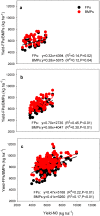Exploiting Co-Benefits of Increased Rice Production and Reduced Greenhouse Gas Emission through Optimized Crop and Soil Management
- PMID: 26452155
- PMCID: PMC4599856
- DOI: 10.1371/journal.pone.0140023
Exploiting Co-Benefits of Increased Rice Production and Reduced Greenhouse Gas Emission through Optimized Crop and Soil Management
Abstract
Meeting the future food security challenge without further sacrificing environmental integrity requires transformative changes in managing the key biophysical determinants of increasing agronomic productivity and reducing the environmental footprint. Here, we focus on Chinese rice production and quantitatively address this concern by conducting 403 on-farm trials across diverse rice farming systems. Inherent soil productivity, management practices and rice farming type resulted in confounded and interactive effects on yield, yield gaps and greenhouse gas (GHG) emissions (N2O, CH4 and CO2-equivalent) with both trade-offs and compensating effects. Advances in nitrogen, water and crop management (Best Management Practices-BMPs) helped closing existing yield gaps and resulted in a substantial reduction in CO2-equivalent emission of rice farming despite a tradeoff of increase N2O emission. However, inherent soil properties limited rice yields to a larger extent than previously known. Cultivating inherently better soil also led to lower GHG intensity (GHG emissions per unit yield). Neither adopting BMPs only nor improving soils with low or moderate productivity alone can adequately address the challenge of substantially increasing rice production while reducing the environmental footprint. A combination of both represents the most efficient strategy to harness the combined-benefits of enhanced production and mitigating climate change. Extrapolating from our farm data, this strategy could increase rice production in China by 18%, which would meet the demand for direct human consumption of rice by 2030. It would also reduce fertilizer nitrogen consumption by 22% and decrease CO2-equivalent emissions during the rice growing period by 7% compared with current farming practice continues. Benefits vary by rice-based cropping systems. Single rice systems have the largest food provision benefits due to its wider yield gap and total cultivated area, whereas double-rice system (especially late rice) contributes primarily to reducing GHG emissions. The study therefore provides farm-based evidence for feasible, practical approaches towards achieving realistic food security and environmental quality targets at a national scale.
Conflict of interest statement
Figures




References
-
- Dobermann A, Nelson R, Beever D, Bergvinson D, Crowley E, Denning G, et al. Solutions for sustainable agriculture and food systems Technical report for the post-2015 development agenda. New York: Sustainable Development Solutions Network; 2013.
-
- Pandey S, Byerlee D, Dawe D, Dobermann A, Mohanty S, Rozelle S, et al. Rice in the global economy: strategic research and policy issues for food security. Los Banos: International Rice Research Institute; 2010.
-
- Chen HZ, Zhu DF, Yang SH, Zhang YP, Lin XQ. The difference and potential of rice yield in southern China. China Rice. 2004; 4: 9–10 (in Chinese with English abstract).
Publication types
MeSH terms
Substances
LinkOut - more resources
Full Text Sources
Other Literature Sources
Miscellaneous

